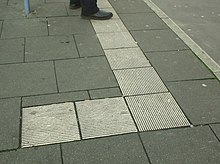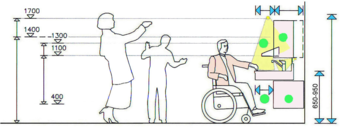Barrier-free building
Barrier-free construction - completely barrier-free planning and building - means apartments, buildings and public places to such plan and build to accessibility are so by all people without assistance and can be used without any restriction.
Barrier-free construction means the timely planning and implementation of structural measures that enable the use of a building, facility, public place, etc. by all people. Instead of the term “barrier-free building”, the terms “handicapped-friendly building”, “building for all”, “humane building” or “ design for all ” (products, systems and services are intended for the largest possible user group in the broadest possible environment be usable) used. The basis for this are various standards and legal regulations.
Target groups and their demands
For many people, barrier-free construction is an indispensable prerequisite for being mobile and being able to participate in social life.
People with restricted mobility, people with walking disabilities, paralysis or missing limbs who are often dependent on aids such as wheelchairs, walking frames, walking aids or just grab bars or railings, but also tall or short people, including children, people with luggage or prams need, in order to be able to move freely, above all sufficient space, passages must be sufficiently wide and high, installation surfaces sufficiently long. Areas of movement have to be level, differences in height or steps are barely negotiable obstacles for many. Buttons, handles or the like must be at the right height in order to B. easy to reach from a wheelchair.
People who are limited in their perception or information processing need, for example, clear room arrangements; Blind and visually impaired people also have tactile edges or floor indicators .
Wheelchair ramp in Stanford University , San Francisco
A counterexample: The footbridge over the ancient bath ruins in Badenweiler cannot and must not be used
Stairs street in Kassel, the ramp is too steep for real accessibility
Accessibility of a museum: Theseus temple in Vienna
Accessibility in the household
Accessibility is achieved within apartments by:
- Safe to use and easily accessible installations, especially in the kitchen and bathroom,
- Securing mobility by avoiding heels and bumps and
- generously dimensioned movement areas.
Norms and standards

- Germany
From a legal point of view, the DIN standards in Germany are initially recommendations that do not have to be applied. However, the state authorities can make stipulations in their building codes that ensure compliance with accessibility standards for certain buildings or systems, e.g. B. "Buildings with more than one apartment". Different regulations can be made depending on the federal state.
The following standards are currently largely introduced as technical building regulations in almost all federal states (except North Rhine-Westphalia):
- DIN 18024 -1 Barrier-free construction - Part 1: Streets, squares, paths, public transport, recreation areas and playgrounds; Planning principles
- DIN 18040-1 Barrier-free building - Part 1: Publicly accessible buildings (replaces DIN 18024-2 Publicly accessible buildings and workplaces )
- DIN 18040-2 Barrier-free building - Planning principles - Part 2: Apartments (replaces DIN 18025-1: 1992-12 and DIN 18025-2: 1992-12)
- DIN 32984 floor indicators, guide strips etc. (supplement to DIN 18040)
- DIN 32975 design information in public spaces (supplement to DIN 18040)
Not yet anchored in building law, but already published as a standard:
- DIN 18040-3: Barrier-free building - Planning principles - Part 3: Public traffic and open space (replaces DIN 18024-1: 1998-01 Barrier-free building - Part 1: Streets, squares, paths, public traffic and green spaces).
Drafts not pursued further:
- DIN 18070 (draft): Barrier-free construction - Public transport and open space - was a new version and replace the DIN 18024 -1 Barrier-free construction - Part 1: Streets, squares, paths, public transport, recreation areas ... provided. Instead, however, DIN 18040-3 was developed and published in December 2014.
- DIN 18030 (draft) from 2006 was intended to replace DIN 18024 and 18025, but failed due to numerous objections and was not completed.
- Austria
Developed by the technical standards committee 011 general building construction
- ÖNORM B 1600: 2011 Barrier-free building - planning principles.
- ÖNORM B 1601: 1994 Special buildings for disabled and old people: planning principles.
- ÖNORM B 1602: 2001 Barrier-free schools and training facilities and accompanying facilities.
- ÖNORM B 1603: 2005 Planning principles for barrier-free tourism facilities
Switzerland
Developed by the VSS research and standardization in the road and traffic sector. Publisher: Swiss Association of Road and Transport Experts .
- SN Norm 640 075: 2014 de / for pedestrian traffic, barrier-free traffic area
- SN Norm 640 075: 2014 de / for pedestrian traffic, barrier-free traffic area, explanations, requirements and dimensions - normative annex
Awards for barrier-free construction
- Schindler Award - architectural competition for barrier-free building
- Concrete head (price) - negative price for particularly drastic violations of barrier-free construction
See also
- Wheelmap.org , an online map for finding and marking accessible places
literature
- General
- Roland König: Guide to barrier-free housing Fraunhofer Irb Stuttgart, June 2005, ISBN 3-8167-6789-3
- Literature list on the subject of barrier-free building www.rehadat.de
- Wendelin Mühr: Handbook of Barrier Free in Traffic Areas - GUIDELINES for planning and construction (edition 2011-10) www.barrierefrei-mobilitaet.de
- Barrier free! City without obstacles? - Vienna (PDF; 29.3 MB)
- Joachim F. Giessler: Planning and building for living in old age - guide for new building, conversion and renovation Blottner Verlag Taunusstein, 2005, ISBN 978-3-89367-099-4
- Standards in Germany
- Federal Office for Building and Regional Planning (Ed.): Technical principles for barrier-free building. BBR online publication. Bonn 2005 ( web document )
- Barrier-free planning and building - DIN-Taschenbuch 199, Beuth, Berlin 2012, ISBN 978-3-410-20735-1
- Franz-Georg Rips: Accessibility according to § 554a BGB, Deutscher Mieterbund Berlin, 2003, ISBN 3-933091-50-0
- Standards in Austria
- Heinrich Geuder, Wolfgang Hauer (Ed.): Viennese building regulations. 3rd edition, Linde, Vienna 1997
- Henrietta Geuder: Austrian public building law and spatial planning law: an overview. Linde, Vienna 1996
- Friedrich Krzizek: System of Austrian building law. Verl. D. Austrian Staatsdr., Vienna 1976 - Building Police Law
Web links
- Barrierefrei NRW website of the project of the Ministry of Social Affairs of the state government of NRW
- Access for everyone - Swiss Foundation for the use of technology for the disabled
- ftb-net.de/info/ Barrier-free living - guidelines and recommendations
- ECA 2008, ECA 2013, ECA 2017 (European Concept for Accessibility)
- nullbarriere.de - barrier-free, plan - build - live
Individual evidence
- ↑ Information and content DIN 18040-1
- ^ Ministry of Labor, Social Affairs, Family and Health Rhineland-Palatinate. Barrier-free Rhineland-Palatinate . ( Memento from May 6, 2006 in the Internet Archive )
- ↑ Complete directory: search for “barrier-free building”. Austrian Standards Institute, archived from the original on March 9, 2014 ; Retrieved April 16, 2014 .





